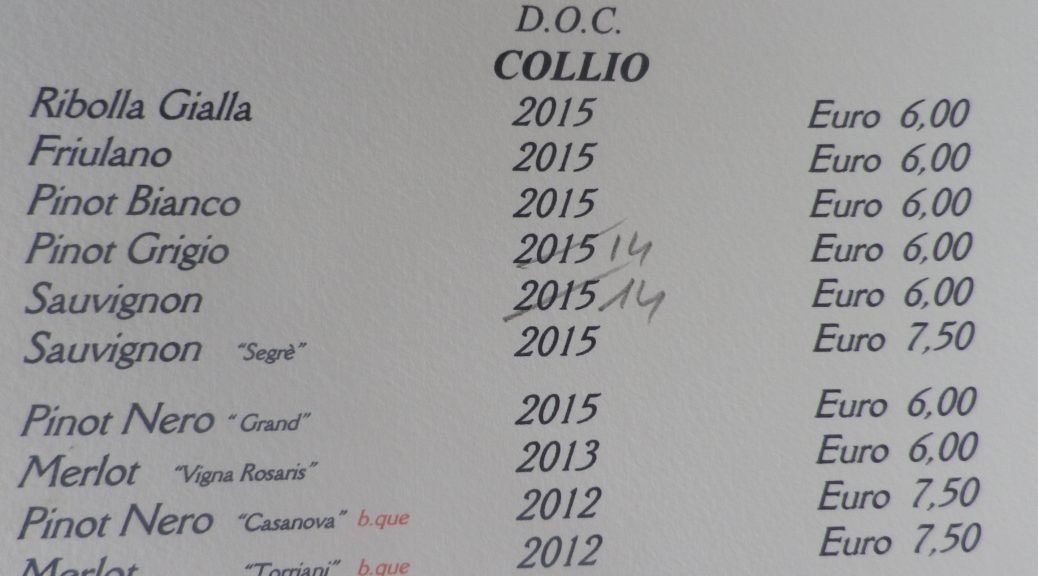What I Learned
In the far northeast corner of Italy, bordered on the north and east by Slovenia, lies Italy’s wine paradise of the Collio. Not to be confused with its northern and western wine region neighbor, the Colli Orientale di Friuli, the Collio region likewise falls within the Italian region of Friuli. The Collio wine region, which has its own Denominazione di Origine Controllata (DOC) status, is a relatively small enclave of approximately 1600 hectares (about 4000 acres), running south to north from Gorizia to Dolegna. Cormons, a town larger in fame within wine circles than in size, is at its spiritual, if not geographical, center.
The vineyards here face primarily south. Rolling hills, characterized by Flysch and calcareous marl strata, result in terroir rich in lime, phosphorous and potassium. It is very friable, which means that terracing is necessary in many places.
This region focuses primarily on white varietals. These are in large measure Pinot Grigio, Friulano, Sauvignon, and Chardonnay. However, Muller-Thurgau, Pinot Bianco, Ribolla, and Riesling are also found here in significant quantities. The Friulano varietal is something quite special, regionally, and it has many synonyms. Tokai Italico, Tocai Friulano, or variations thereof, all refer to the Sauvignonasse grape. Formerly known simply as Tocai, this apparently caused confusion with the Hungarian wines called Tokaj. Litigation determined that the Italian labelling had to change. In any case, the new name reflects the fact that while this varietal may grow in other Italian wine regions as well, it does particularly well in the Friuli.
Merlot and Cabernet Franc are the predominant red varietals.
In the cellar, the focus tends to be on retaining the fruitiness of the varietal. While blends are allowed by regulation, only 15% of a different varietal may be in any varietal-labelled wine. In the case of the white varietals, this is one of the first regions in Italy to use cold fermentation techniques. The results are clean, crisp and mostly dry white wines, with a marked fruitiness, devoid of oak flavor, as most white wines are not barrel-aged.
What I Tasted
2016 Pinot Grigio, Collio, DOC, Azienda Gradis’ciutta: A dry white wine with medium gold color; a fruity, white stone fruit nose, with spicy vanilla and white stone fruit flavors with a hint of yeast; medium plus acidity.
2015 Friulano, Collio, DOC, Castello di Spessa (Capriva del Friuli): A dry, white wine with medium gold color; a vegetal and grassy nose, and with nuts and ripe white fruits flavors; low acidity with a smooth finish.
2014 Pinot Grigio, Collio, DOC, Castello di Spessa (Capriva del Friuli): A dry white wine with a lighter medium gold color; complex nose of grass, white floral (to include honeysuckle) and mineral nose; white floral, honey and slight citrus flavors; medium acidity with a refreshingly tart finish.
2013 Tokai Italico (Friulano), Collio, DOC, Azienda Vinicola Col Blancis di Ezio Cicuto (Portogruaro and Mossa): A dry white wine with light gold color; a spicy nose with honey and vanilla flavors along with a hint of smoke; smooth, with medium acidity.
2012 Pinot Nero, Casanova, Collio, Denominazione di Origine Controllata (DOC) Castello di Spessa (Capriva del Friuli): A dry red wine with dark red color; a spicy nose, and with dried prunes, vanilla, and slight oak flavors; medium tannins.
